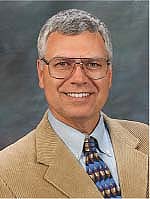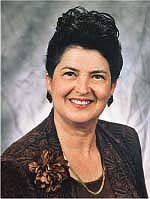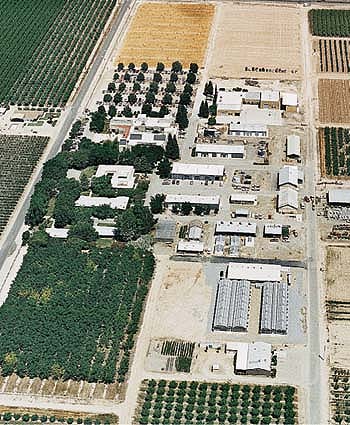All Issues
Collaboration fosters Kearney scientific achievements
Publication Information
California Agriculture 59(2):53-55.
Published April 01, 2005
PDF | Citation | Permissions
Full text
UC's Kearney Research and Extension Center (KREC) lies at the heart of one of the most productive and diverse agricultural regions in the world. Also an area of environmental challenges, Kearney's field sites have supported decades of landmark research, addressing issues as diverse as air pollution effects, the development of exotic specialty crops, and the rapid molecular diagnosis of plant disease.
First dedicated as the Kearney Horticultural Field Station in 1965, KREC is one of nine UC Research and Extension Centers (RECs). All are strategically located in key agricultural regions of the state, but Kearney is unique among them in its size and scope. Functioning as a small research campus, KREC encompasses 33 specialized laboratories and hosts the UC Kearney Agricultural Center (KAC), with 24 permanent resident faculty. In addition, 20 to 25 faculty from UC campuses and county UC Cooperative Extension (UCCE) offices conduct research at KREC each year. The center currently supports 90 research and extension projects in 130 different field and laboratory locations. KREC also houses the UCCE Central Valley regional office.
The cutting-edge and practical research conducted at Kearney has helped San Joaquin Valley agriculture become a $16 billion industry, yielding roughly half of California's farm production. This issue of California Agriculture commemorates the 40th anniversary of KREC with reviews and reports on recently completed research, much of which has immediate relevance to farmers, packers and shippers.
Kearney has seen steady expansion, modernization and diversification over its 40-year history. Its laboratories and greenhouse facilities rival those found on the UC campuses, and its postharvest facility is state-of-the-art. The center encompasses a variety of alluvial soil types, and more than 50 different crops are cultivated under commercial growing conditions. This combination of land, laboratories and greenhouses enables UC scientists to conduct studies in a carefully managed setting. Professional staff monitor cultivated crops and continually check the operation of sophisticated laboratory facilities.
Collaborative environment
Located in the center of a remarkable agricultural region, Kearney fosters interactions with industry, government agencies, environmental and public policy groups, and university scientists. Whether on small research plots, in laboratories or on-site conference facilities, growers and scientists meet here daily in the collaborative spirit envisioned by the creators of the land-grant university system.
Since 1983, the resident research and extension faculty have been organized as KAC. About 100 laboratory staff help investigators carry out field and laboratory studies at KREC and off-site in grower fields and packinghouses.
The KAC faculty are multidisciplinary with scientific expertise in horticultural and agronomic crops, nematology, entomology, plant pathology and physiology, air quality, weed control and mosquito research. The nucleus of resident KAC scientists creates an academic atmosphere that attracts campus and county-based collaborators. The recent completion of the U.S. Department of Agriculture's San Joaquin Valley Agricultural Sciences Center across the road from KREC has widened the circle of collaboration.
The frequent interaction between scientists and industry that is the hallmark of Kearney generates new questions and research approaches, aids in the identification of additional research needs, and extends new information rapidly. Intercampus collaboration also fuels “outside the box” thinking and creates efficiencies in the utilization of research plantings, modern research facilities and specialized equipment.
GIS expertise
KAC operates a complex computer network, a graphic arts department and a Geographic Information Systems (GIS) Facility. GIS allows researchers to explore the spatial distribution of pests, crops and pathogens, and to study the interactions that develop as a result of the patchwork of land use in the San Joaquin Valley. For example, adjacent cotton and alfalfa fields must be managed carefully to control Lygus bugs. GIS techniques now permit KAC-based scientists to post maps that allow growers and pest control advisors to enter data on pest populations, pesticide use and other information directly onto the map-based data archive. Resulting spatial analyses have led to regional approaches to integrated pest management (IPM) of Lygus bug, leafhoppers, peelminers, avocado thrips, olive fly and mosquitoes that vector human diseases.
GIS techniques facilitate the preparation of special-purpose maps and other materials of benefit to agricultural clientele, regulators and the public. Scientists have access to Web-based survey techniques hosted by the Kearney GIS Facility.
Numerous scientific achievements
Living and working in the San Joaquin Valley has led to a number of important discoveries by KAC faculty and collaborators. For example, cultivation techniques are now used routinely to manage summer bunch rot in grapes; a pruning technique known as the “Kearney V” allows for dense planting of orchard crops and earlier harvests ( see page 75 ); and pruning and trellising strategies have been developed to allow raisins to dry on the vine ( see page 70 ). Kearney-based plant pathologists and plant breeders have addressed the problem of root infections that limit yield and plant survival ( see page 63 ).
Plant breeding efforts at KAC led to the UCBI hybrid rootstock of pistachio, combining resistance to Verticillium wilt with tolerance to chilling and salinity. A decade after its introduction, the UC-developed hybrid is the second most-planted pistachio rootstock in California. New varieties of many crops have been developed at Kearney that address local problems, including cherries that can tolerate San Joaquin Valley heat, and the noncaprifying fig ‘Sierra’, which allows more efficient orchard operations and reduces the risk of fruit diseases.
Pest identification and control
Early studies at Kearney led to the initial identification of “arm and cordon death” on grapevines as “Bot canker” (Botryosphaeria rhodina), along with the previously recognized Eutypa lata. Current research is exploring whether other Botryosphaeria species are responsible for this and other disease complexes on grapes in California.
New crops and varieties often bring new suites of pests and diseases. In addition, new pests of existing crops are introduced continuously into California. Recent research has identified the newest diseases in grapes, dried plums and peaches. When a new citrus peelminer arrived from the south in 1999, threatening a wide range of crops, a technique to raise the pest under laboratory conditions was developed by KAC scientists. This allowed scientists to investigate control techniques. When pistachio nuts became a major crop in the San Joaquin Valley, KAC- and campus-based scientists identified major mite and insect pests.
KAC researchers developed diagnostic techniques to predict Botrytis gray mold in kiwifruit, and conventional and molecular genetic procedures to predict Botryosphaeria blight in pistachio and Monilinia brown rot in tree fruit. Entomologists developed temperature-based phenology models to predict outbreaks of oriental fruit moth, San Jose scale and peach twig borer. These advance-warning techniques allow timely management and marketing decisions, and reduce pesticide applications. A Web-based IPM decision support system ( http://tjm.uckac.edu ) extends this information to growers. Kearney scientists have developed practical management techniques for endosepsis and smut in figs, Botryosphaeria blight in pistachio, and aflatoxin contamination of pistachios and figs.
Research at Kearney has considerably advanced the mating disruption and trapping of pest insects. Pheromones (natural insect communication chemicals) for San Jose scale, vine mealybug and peach twig borer were identified through collaborations between KAC researchers and colleagues from around the country. Mating disruption of oriental fruit moth now controls this pest in stone fruit orchards, the first success of this kind in North America.
As control technologies were implemented, target organisms have developed resistance. Research has determined the mechanism of resistance of Alternaria late blight pathogen of pistachio to a new class of fungicides, the strobilurins. The existence and spatial distribution of resistance of California red scale and San Jose scale to organophosphates and carbamates was discovered at KAC. Using this information, local growers achieved a 70% reduction in use of these materials, and now use insect growth regulators (IGRs) as pest management tools in the San Joaquin Valley.
Changing pesticide usage leads to other changes in agroecosystems. The adoption of IGRs led to disruption of the vedalia beetle, which allowed cottony cushion scale to re-emerge as a serious citrus pest. Again, research at KAC led to the development of management techniques for this pest. Such research is critical to production today, and in adapting solutions for tomorrow's problems.
Cultivation techniques
Cultivation research at Kearney has explored the advantages of no-till planting and cover crops, as well as the use of reflective and straw mulches to repel insects and the viruses they carry, suppress weeds, conserve water and improve profits ( see page 90 ). This work is now being applied to the mitigation of dustemissions from agricultural operations, a potential source of particulate matter in the air. Other research has found that crops in the San Joaquin Valley remove substantial ozone air pollution from the air, with the unfortunate side effect of reducing yields and inhibiting root development and the uptake of water by certain crops ( see page 137 ).
Solarization of perennial crops and more recently of annual crops has been developed at Kearney, using the heating power of sunlight to reduce soil pathogens ( see page 84 ). This work is taking on new importance with the phaseout of methyl bromide. Recently a “double tent” approach to solarization developed at Kearney was registered by the California Department of Food and Agriculture for nursery control of nematodes in containers. KREC has supported the IR-4 field research program, which evaluates reduced-risk pesticides that would otherwise be unavailable to growers of high-value “minor” crops.
Cultivation techniques developed at Kearney have led to border cutting of alfalfa to keep beneficial insects in alfalfa fields rather than causing their dispersion during complete harvests, and to keep pests such as Lygus bugs from migrating to cotton. Use of this technique was reported by 40% of alfalfa growers responding to a recent KAC survey.
Extension to Valley residents
KREC is also home to the Central Valley Regional UCCE office, providing management for county extension efforts throughout the Valley. UCCE provides instruction and demonstration of improved practices in agriculture, natural resources, nutrition, family and consumer science, and 4-H youth development. Kearney has become a focal point of regional activities by UCCE advisors based in neighboring counties as well. At KREC, farm advisors work with their academic partners from the campuses and KAC faculty to conduct agricultural and environmental research. The meeting facilities at KREC host thousands of visitors each year for CE events designed to extend applied, research-based information to industry and other clientele. Field days at KREC provide growers with an opportunity to discover the most recent research developments, and to discuss them directly with the scientists conducting the studies.
As the agricultural economy of California enters a time of increased globalization and competition, and urban development threatens the richest farmland, research by Kearney scientists — and its delivery to many clienteles — will continue to provide solutions to problems of immediate and long-term concern.









